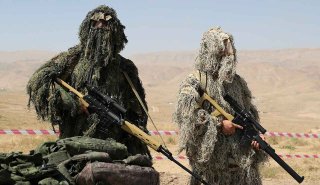Russia and America Have Been Stealing Each Other's Weapons for Years
Captured arms can yield big secrets.
In December, Russian social media outlets were quick to tout how an American M1 Abrams main battle tank (MBT) was being sent to the Uralvagonzavod research and development facility for evaluation. The tank had been among the 31 donated to Kyiv, and it is believed to be the first captured intact. According to a post on social media, the Abrams was first spotted on the back of a flatbed truck on December 26, 2024.
Of course, the U.S. has also been examining a captured T-90, among the most advanced Russian MBTs now in service in Ukraine. It was spotted in April 2023 on a trailer at a truck stop off U.S. Interstate 10 in Roanoke, Louisiana. The truck hauling it had broken down, and the Russian MBT remained in the parking lot for several hours until a replacement truck was sent. Pentagon officials later confirmed it was being sent to the Aberdeen Proving Ground, and likely had entered the U.S. through a port in Texas or Louisiana.
It is now possible that another Russian weapon could also get a close examination.
According to a post on X from the open-source military analysts OSINTtechnical, Ukrainian troops recently captured a Russian VSS-M Vintorez suppressed marksman rifle. It was reportedly "retrofitted with a Russian thermal sight (likely forcefully requisitioned from a Russian spetsnaz operator)."
The WSS-M Vintorez is a modernized version of the WSS Vintorez, a weapon that is known for its unique 9x39mm subsonic ammunition. The special ordnance has a muzzle velocity of less than 1,115 feet per second and produces no sonic boom. When coupled with the rifle's built-in suppressor, it is about as silent as it gets, yet still is able to penetrate lighter body armor. However, as Essanews reported, it is still "inadequate against modern ballistic plates of the fourth class of the American NIJ ballistic standard."
The modernized gas-operated sniper rifle entered service with the Russian military circa 2018, and the ongoing war in Ukraine may be its first deployment in combat. As noted, in addition to the VSS-M Vintorez, the Ukrainian operator was employing a thermal sight that is largely used by the Kremlin's Spetsnaz elite special forces personnel.
Small Arms – Big Secrets
Captured small arms can yield big secrets. In part, the weapons can offer insight into the production capabilities but also the latest enhancements.
That explains why the CIA and other Western intelligence agencies paid $5,000 to the Afghan Mujahedeen for the first captured AK-74, the 5.45x39mm version of the AK-47 that entered service in 1976.
More recently, in late 2022, the United States Army’s Contracting Command-New Jersey (CCNJ) issued a notice that it was seeking AK-74 assault rifles for training and evaluation purposes.
Past Efforts to Obtain Soviet Weapons
During the Cold War, the United States went to great lengths to obtain Soviet military hardware. For more than a decade, the CIA sought to obtain a T-72 MBT, without any success.
So sought after was the tank that during the production of the film Red Dawn, the agency inquired after a prop version was spotted in California. However, it was a mock-up built on the chassis of a surplus M8A1, which was based on the M41 Walker Bulldog. Numerous attempts to smuggle a tank – not exactly a small object – proved unsuccessful. But finally, in 1987, one was acquired by way of a Romanian arms dealer who sold a former Romanian military T-72 as scrap metal.
The U.S. military had a bit more luck obtaining a Mi-24 (NATO reporting name Hind) helicopter. After also spending more than a decade trying to obtain one – during which time Soldier of Fortune infamously offered a $100,000 bounty, later raised to $1 million – the opportunity came knocking in 1988 when a Libyan Mi-25 Hind-D, the export model of the Mi-24, was damaged and discarded during the border war with Chad.
After receiving intelligence that the helicopter had been abandoned, the Pentagon jumped into action. The U.S. Army's 160th Special Operations Aviation Regiment conducted a "practice run" recovery mission in New Mexico and then dispatched a pair of MH-47 Chinooks to the North African desert. Dubbed Operation Mount Hope III, the mission saw the U.S. choppers fly 500 miles at night to the crash site and in the early dawn hours, crews recovered the downed Soviet-made helicopter and then flew back to a temporary airstrip in a sand storm. The Hind-D was loaded aboard a C-6 Galaxy cargo plane and returned to the United States.
Peter Suciu is a Michigan-based writer. He has contributed to more than four dozen magazines, newspapers, and websites with over 3,200 published pieces over a twenty-year career in journalism. He regularly writes about military hardware, firearms history, cybersecurity, politics, and international affairs. Peter is also a Contributing Writer for Forbes and Clearance Jobs. You can follow him on Twitter: @PeterSuciu. You can email the author: [email protected].
Image: Wikimedia Commons.

